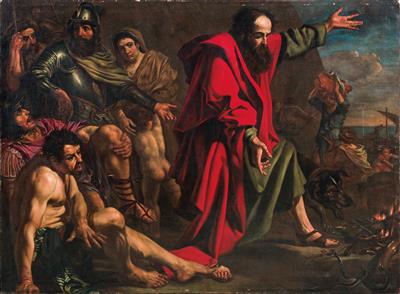Flemish Caravaggist Painter, 17th Century

Saint Paul destroying the Serpent,
oil on canvas, 163.5 x 220.5 cm, unframed
Provenance:
probably sale Christie’s London, 1953, lot 103 (as Caracciolo);
probably with Gilberto Algranti, Milan, 1987 (as Gerard Douffet);
Private collection, Bologna
Literature:
probably B. Nicolson, Caravaggism in Europe, 1989, vol. II, ill. no. 712 (as Valentin?, with measurements 157.5 x 210.8 cm);
probably M. Mojana, Valentin (under ‘erronee attribuzioni’, with measurements 157.5 x 210.8 cm)
The painting depicts the episode narrated in Acts (28.3) of the landing on the island of Malta by Saint Paul and other prisoners after the sinking of their ship on the way to Rome. Greeted kindly by the locals around a fire, Paul was bitten by a deadly snake but “he shook off the beast into the fire, and felt no harm” (28.5).
The saint, depicted with the dark bushy beard that traditionally distinguishes him from Saint Peter, wears a green tunic with red cape, constituting the visual centrepiece of the composition, and with an emphatic gesture turns his gaze down at the snakes. To the left, a number of soldiers and locals look on in amazement at the scene they are witnessing, while on the right, beyond a rocky cliff forms a backdrop to the scene, the sky has cleared and the remains of the wrecked ship can be seen. The dramatic tension of the episode is enhanced by the close-cropped nature of the composition, with the saint occupying the vertical surface of the painting, as well as by the dramatic group on the left, marked by the different poses of the characters.
The present work has been attributed to a Flemish artist active in Rome in the second decade of the 17th century, deeply influenced by Caravaggio’s style. It has been suggested that it may be by Gerard Douffet. After frequenting the workshop of Rubens in Antwerp between 1612 and 1614, the Liège-born Douffet moved to Rome for about ten years, where he lived from 1620 to 1622 with the artist Valentin. He probably also travelled to Venice, Naples and Malta before finally returning to his hometown. However, there is no information on the artist’s Roman phase, as his first known works were painted in Liege in the 1620s.
18.10.2016 - 18:00
- Odhadní cena:
-
EUR 30.000,- do EUR 40.000,-
Flemish Caravaggist Painter, 17th Century
Saint Paul destroying the Serpent,
oil on canvas, 163.5 x 220.5 cm, unframed
Provenance:
probably sale Christie’s London, 1953, lot 103 (as Caracciolo);
probably with Gilberto Algranti, Milan, 1987 (as Gerard Douffet);
Private collection, Bologna
Literature:
probably B. Nicolson, Caravaggism in Europe, 1989, vol. II, ill. no. 712 (as Valentin?, with measurements 157.5 x 210.8 cm);
probably M. Mojana, Valentin (under ‘erronee attribuzioni’, with measurements 157.5 x 210.8 cm)
The painting depicts the episode narrated in Acts (28.3) of the landing on the island of Malta by Saint Paul and other prisoners after the sinking of their ship on the way to Rome. Greeted kindly by the locals around a fire, Paul was bitten by a deadly snake but “he shook off the beast into the fire, and felt no harm” (28.5).
The saint, depicted with the dark bushy beard that traditionally distinguishes him from Saint Peter, wears a green tunic with red cape, constituting the visual centrepiece of the composition, and with an emphatic gesture turns his gaze down at the snakes. To the left, a number of soldiers and locals look on in amazement at the scene they are witnessing, while on the right, beyond a rocky cliff forms a backdrop to the scene, the sky has cleared and the remains of the wrecked ship can be seen. The dramatic tension of the episode is enhanced by the close-cropped nature of the composition, with the saint occupying the vertical surface of the painting, as well as by the dramatic group on the left, marked by the different poses of the characters.
The present work has been attributed to a Flemish artist active in Rome in the second decade of the 17th century, deeply influenced by Caravaggio’s style. It has been suggested that it may be by Gerard Douffet. After frequenting the workshop of Rubens in Antwerp between 1612 and 1614, the Liège-born Douffet moved to Rome for about ten years, where he lived from 1620 to 1622 with the artist Valentin. He probably also travelled to Venice, Naples and Malta before finally returning to his hometown. However, there is no information on the artist’s Roman phase, as his first known works were painted in Liege in the 1620s.
|
Horká linka kupujících
Po-Pá: 10.00 - 17.00
old.masters@dorotheum.at +43 1 515 60 403 |
| Aukce: | Obrazy starých mistrů |
| Typ aukce: | Salónní aukce |
| Datum: | 18.10.2016 - 18:00 |
| Místo konání aukce: | Wien | Palais Dorotheum |
| Prohlídka: | 08.10. - 18.10.2016 |
